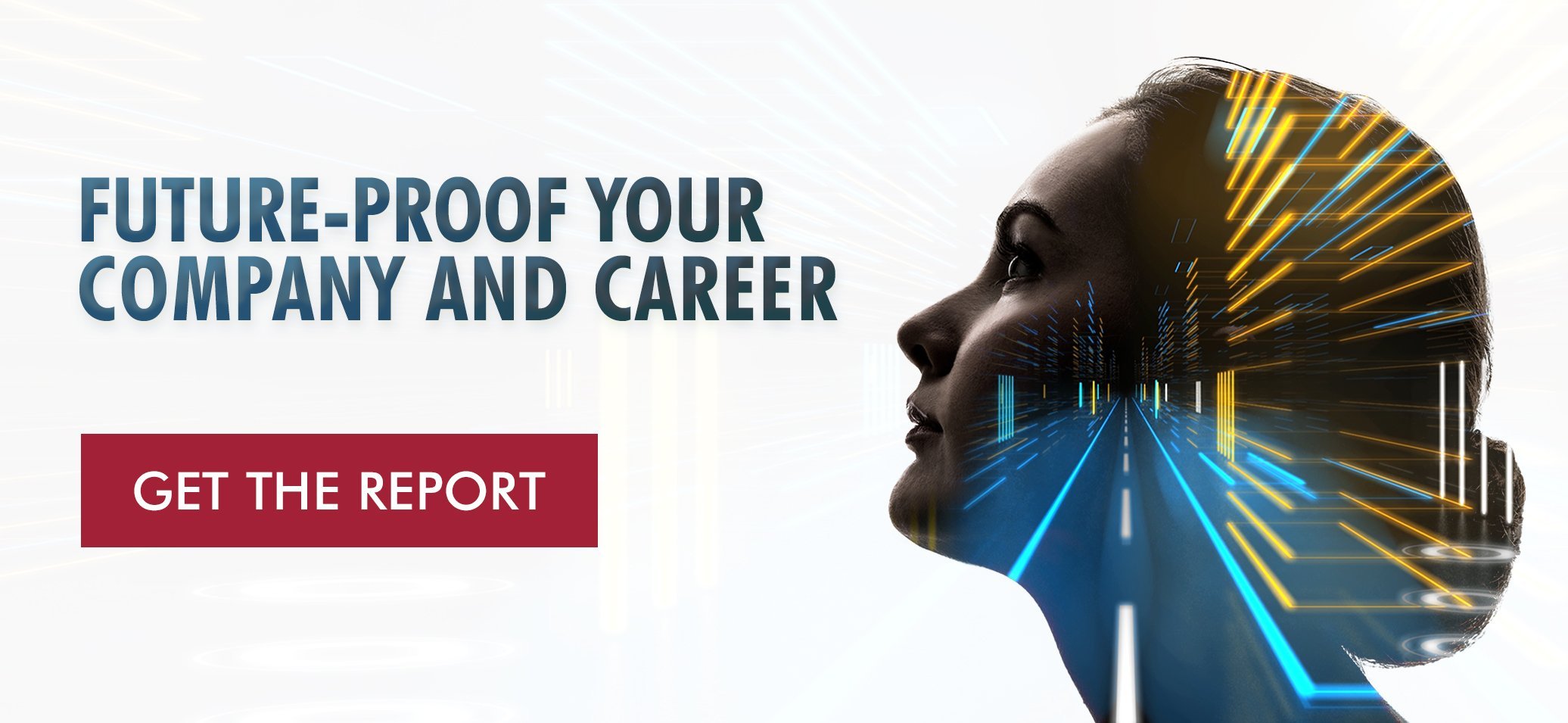The rapid pace of technological change has businesses scrambling to keep up. But staying on top of digital innovation isn’t just a matter of migrating to the cloud, handing over routine tasks to robotic process automation (RPA), or experimenting with emerging technologies like artificial intelligence (AI). It’s also about helping today’s employees evolve into tomorrow’s workers. And a key question on many employers’ minds today is, “What do we need to do to build our workforce of the future?”
Robert Half’s new report, Jobs and AI Anxiety, explores the impact of digital change on jobs, including the transformative aspects of AI, immersive technologies like augmented reality (AR) and virtual reality (VR), cloud computing and more. The technology and business experts interviewed for our report also shared their insights on how companies and their workers can step up to embrace change and succeed in the workplace of the future.
Across the board, these experts emphasized the importance of businesses and employees taking a we-are-all-in-this-together approach to digital transformation. In short, you’ll need the partnership of your employees and their buy-in to build your company’s workforce of the future. With that in mind, here are five strategies you can use to help make the transitions ahead a positive experience for you, your company and your team members:
1. Communicate (or even over-communicate) about change
When it comes to digital disruption, which is now a constant state in most organizations, ongoing communication is vital. When a company is in a period of transition, uncertainty can easily breed rumors, resentment and stress among workers. That’s partly because change can make employees feel insecure about their jobs.
“Business leaders should instill the idea that digital disruption can be a positive force rather than something to fear,” says Paul McDonald, senior executive director at Robert Half. “For example, when adopting a new system or application, explain how that technology will allow team members to work more efficiently.”
Underscoring how new technologies, like RPA and AI, can free up time to focus on more challenging, interesting and impactful projects will help workers embrace change. Also, sharing accurate and pertinent information with employees about digital disruption helps to promote a healthy dialogue that can keep everyone focused on the facts, McDonald says.
2. Give workers the opportunity to evolve their skills
A big part of preparing the workforce of the future is retraining and reskilling your employees. This investment makes good business sense: Providing team members with access to new technologies and the associated training to use them in their jobs can give companies a recruiting, retention and performance boost.
Dan Schawbel, research director at Future Workplace, who was interviewed for the Jobs and AI Anxiety report, says, “Investing in your workers is smart. Retraining employees not only can help save the business money in the long run but also helps them advance in their career.”
Retraining and reskilling is a two-way street, though: Companies can provide support, but employees also have to be willing to adapt. Our research for the Jobs and AI Anxiety report finds that managers in the United States see evolving workers’ tech skills as a collaborative process. Their top response to the survey question, “Whose responsibility is it to help employees gain the skills needed to work with new technologies?” was “Primarily the company’s, but with some help from the employee.”
The survey of 1,200 U.S. managers also suggests that many companies recognize the importance of investing in their current employees as a way to build their workforce of the future. Nearly two-thirds (64%) of managers surveyed said they intend to train their current staff to ensure they have the requisite skills to take advantage of new technologies.
3. Let go of yesterday’s approaches to learning
Developing your workers so they can stay relevant in the workforce of the future will require you to rethink how you train and develop them. That once-a-year seminar or online training course probably won’t be enough. In an interview for the Jobs and AI Anxiety report, Colin Mooney, chief digital officer at Robert Half, said, “Leaders need to look regularly at their professional development programs, and not rely on what’s worked in the past.”
Continuous learning — encouraging employees to keep growing their knowledge and skills and providing them with the support and resources to do so — is a more effective strategy in a rapidly changing technology and business environment. So, too, are mobile learning programs and tools, which allow employees, including remote workers, to expand their skills from anywhere.
The career discussions you have with your employees also need to occur more often if you want your workers to prepare adequately for coming changes. That’s the advice of Dr. Tracey Wilen, a researcher and speaker on the impact of technology on society, work and careers, who was interviewed for Robert Half’s Jobs and AI Anxiety report. She recommends that employers provide their teams with targeted and meaningful professional development and training opportunities.
“Listen to what your workers want and need,” Wilen says. “Also, let them know it’s okay for them to look for new job opportunities within your organization when they feel it’s time to make a change.”
Another tip from Wilen: Create, and keep evolving, a basic “techno-literacy plan” for all of your workers. Components of that plan might include cybersecurity best practices, understanding how to share confidential information electronically, and how to get the most from the company’s collaboration tools. “Technology is a language, and anyone can learn it,” she says.
4. Don’t dismiss delegation as a tool for preparing workers
When your organization is undergoing disruptive digital change, you may not feel comfortable delegating tasks to your team members. But if you don’t, you’ll rob them of valuable opportunities to grow professionally. That also means they’ll miss out on gaining knowledge and skills that will help them succeed in the workforce of the future. (Plus, not delegating can shorten the path to burnout for you.)
“Delegating work is one option for helping your team build skills,” Wilen explains. “Sharing insight into how the business makes decisions, such as how it budgets for new technology investments, can be valuable.”
Encourage your workers to take ownership of their assignments and don’t micromanage. Let them know you welcome their ideas for improvement or suggestions for taking a different approach than you might have considered. Keep the door open for them to ask questions or share their thoughts or concerns about how they see digital projects changing the work environment.
McDonald says to make delegation effective, managers should also offer recognition and praise to the individual doing the work, along with any constructive criticism, if needed. He adds, “Don’t forget to ask how you could make the process better and help them be more successful.”
5. Watch for tech-related stress in your team
Digital change can be exciting, but it puts a lot of pressure on companies and their employees. That is reflected in our research for the Jobs and AI Anxiety report: Nearly half (47%) of the U.S. managers who said that their company’s increased reliance on technology has had a negative impact on employees pointed to added stress as the top side effect.
So, pay close attention to workers who are feeling stressed out by technological advancements and the changes being introduced. Be sure to emphasize the positive aspects of digital disruption: For example, underscore how automation can reduce the amount of mundane work employees need to perform, or how technologies like VR and AI can help them interact with their colleagues and solve business problems in entirely new ways.
Still, positives aside, too much digital change too quickly can be hard for some employees to digest. As a result, their morale, job satisfaction and productivity can suffer. And if enough employees start feeling that way, it can be a drag on the company’s organizational culture.
McDonald explains why: “The tech-induced stress level in a company’s work environment can have a direct impact on the quality of employees’ workplace relationships. High levels of stress, and persistent stress, can hurt retention efforts and even the company’s ability to recruit talent. So, if an employer manages digital disruption poorly and allows it to erode its employees’ job satisfaction, you can be sure that word will get around.”
6. Let your team know they have what it takes
For some of your team members, preparing to be a productive member of the workforce of the future may be a formidable prospect — especially if they are generally uncomfortable with change. But you can help by reminding them not to underestimate their ability to adapt.
Mooney says he believes anyone is capable of building new skill sets and gaining an understanding of emerging technologies to compete in the workforce of the future. “It’s really a level playing field out there in terms of learning the newest tech skills,” he says. “No one has all the necessary skills for the future of work, at least from a technology perspective, because everything is changing so rapidly.”
It can also be helpful to remind your employees that they are digital changemakers themselves. After all, who started the bring your own device (BYOD) revolution? Who essentially forced their companies to take social media seriously and allow safe access during the workday? Who introduced collaborative tools like Dropbox, Slack and Skype into the workplace? It was employees at all levels who found a new tool or app that works better than what was in place, and then it caught on with the team — a further proof point that digital disruption is just as much about people as technology.






